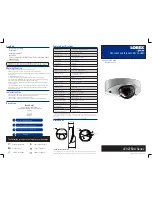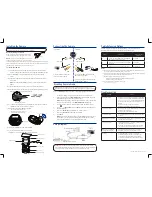
Setup Diagram
Power Adapter
Power
Power
Camera
Extension Cable
BNC
Video Input (supports audio)
Before installing the camera:
Decide whether to run the cables through the wall /
ceiling (drilling required) or along the wall / ceiling.
NOTE:
If you run the cable along the wall / ceiling, it
needs to go through cable notches in the camera base
and cover. This will keep the camera base flush to the surface when mounted. Use pliers to
break off the perforated metal tab on the camera cover, and then align the cable notch in
the camera cover with the cable notch in the camera base.
To install the camera:
1. To separate the camera cover from the camera base, loosen the screws
located on either side of the camera cover using the included Allen key.
2. Use the included mounting template to mark holes for the mounting
screws.
3. Drill the holes and then feed the cable through the mounting surface or
cable notch.
NOTE:
Insert the included drywall anchors if installing the camera in
drywall.
4. Connect cables as shown in the section “Connecting the Camera”.
5. Mount the camera base to the surface using the provided mounting screws.
Make sure all screws are fastened tightly.
Installing the Camera
Cable Extension Options
Extend the cable run for your camera depending on the cable type used.
Additional extension cables sold separately. See table below:
Option
Cable Type
Max Cable Run
Distance
1
Lorex model MCBL-60BNCU / MCBL-60BNCU2
BNC Cable (included with camera)
60ft / 18m
2
‘RG59’ or ‘Coax’ or ‘Coaxial BNC’ Siamese (Video
and Power)
300ft / 92m
3
‘RG59’ or ‘Coax’ or ‘Coaxial BNC’ (Video Only)
2
800ft / 242m
Notes:
1. The extension cable must be a single stretch of cable between the DVR and camera. You
cannot connect multiple extension cables to each other.
2. For cable runs above 300ft / 92m (option 3), you must connect the power adapter directly
to the camera, rather than at the end of the extension cable.
3. Indicators that your cable run may be too long:
• Video is permanently black & white (even during day time)
• Video is unclear, soft, or distorted
4. For more information on extension cables, visit
www.lorextechnology.com.
Problem
Solution
No picture / signal
• Ensure the camera is connected to an MPX Series DVR.
Camera is not compatible with other DVR models. Visit
www.lorextechnology.com
for compatibility information.
• Ensure your DVR is properly connected to your TV /
Monitor.
• Ensure connections are properly connected.
• Ensure the camera power supply is plugged in.
Picture is too bright
• Ensure your camera isn’t pointed directly at a source of
light (e.g. sun or spot light).
• Move your camera to a different location.
Picture is too dark
• Check the brightness and contrast settings of the DVR
or monitor.
Night vision is not working
• The night vision activates when light levels drop. The
area may have too much light.
Picture is not clear
• Check the camera lens for dirt, dust, spider webs. Clean
the lens with a soft, clean cloth.
• Make sure that the cable run is within the limitations
specified in the section ‘Cable Extension Options’.
Bright spot in video when
viewing camera at night
• Night vision reflects when pointing a camera at a
window. Move the camera to a different location.
No audio
• Ensure DVR volume is turned on / turned up
• Ensure audio function on camera is turned on (see
instructions in section ‘Disabling Camera Audio’)
• Ensure audio is turned up on viewing device (Tablet,
Phone, and so on.)
Troubleshooting
To Camera:
To DVR:
Male Power
BNC
1. Connect the BNC and power
connectors to the camera.
Female Power
2. Connect the BNC connector to the
video input of your DVR.
3. Connect the power connector to the
individual power adapter.
Connecting the Camera
01
01
01
Cable Notch
6. Use a Philips head screwdriver (not included) to loosen the lens module
adjustment screw. Do not loosen all the way.
7. Adjust the angle of the camera as needed.
8. Tighten the adjustment screw when finished.
9. Cover the camera base with the camera cover.
10. Tighten the screws on either side of the camera cover.
ATTENTION
- Test each camera prior to selecting a permanent mounting location by
temporarily connecting the camera(s) and cables to the DVR.
A) Turn the lens holder up to 45°.
B) Tilt the lens module up to 90°.
C) Rotate the lens module 360°.
ATTENTION
- This camera includes an Auto Mechanical IR Cut Filter. When the camera
changes between Day/Night viewing modes, an audible clicking noise may be heard from the
camera. This clicking is normal, and indicates that the camera filter is working.
MPX DVR
LEV2750A_SERIES_TRIFOLDQSG_EN_R2
Camera Base
Lens Holder
Lens Module
A
B
C
01
01
01
Mounting Surface
Mounting Template
Drywall Anchors
Mounting Screws
Camera Cover
Camera Mount Screw
Disabling Camera Audio
Audio is
enabled
by default. To disable camera audio through a MPX recorder:
1.
In Live View, double-click the camera channel to open in full-screen.
2.
Right-click and then click
PAN/TILT/ZOOM
. Enter the system user name
and password if prompted. The PTZ menu opens.
NOTE
: If prompted, set the control mode and protocol for the channel that
the camera is connected to in the
PAN/TILT/ZOOM
setting page.
3.
Click the arrow in the PTZ control window to show advanced controls.
4.
Click
. In
Menu Operation
, click
Enter
. The OSD menu appears over
the camera image.
5.
Select the
Advanced
menu using the on-screen controls.
6.
Select the
Audio Mode
option and choose
OFF
.
7.
Click
Enter
.
NOTE:
These instructions are based on current MPX DVR interface. If you
are not able to access your DVR’s OSD menu by following these steps,
please use the instructions in your DVR manual instead.
WARNING
- Audio recording without consent is illegal in certain jurisdictions. Lorex
Corporation assumes no liability for use of its products that does not conform with local laws.
Camera
Adjustment Screw




















